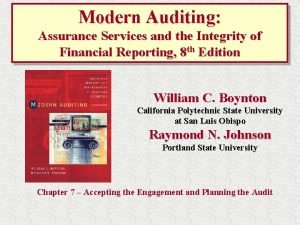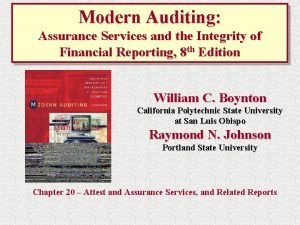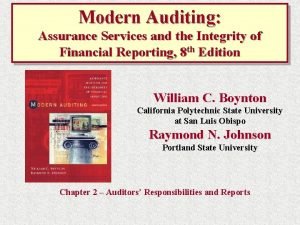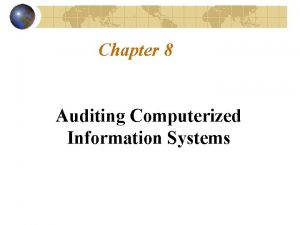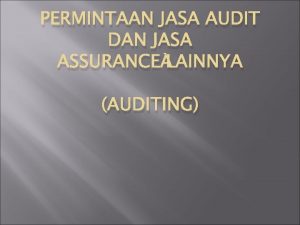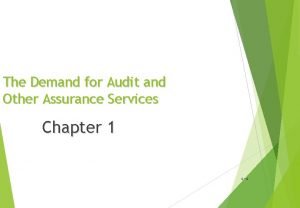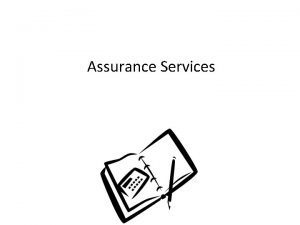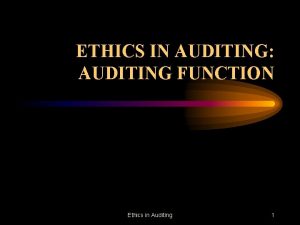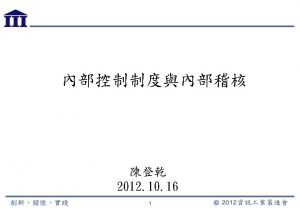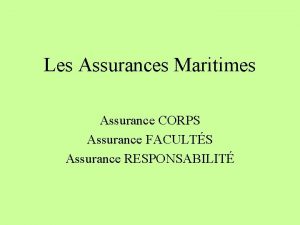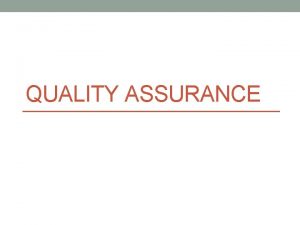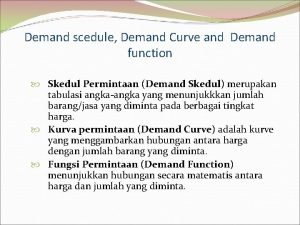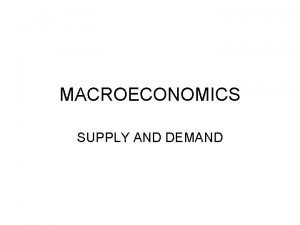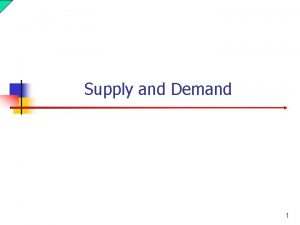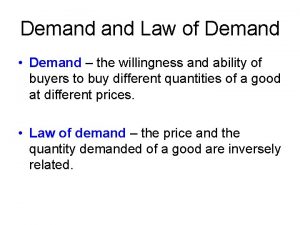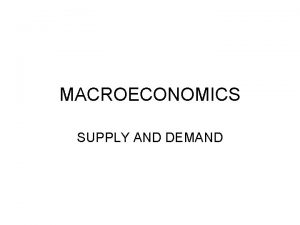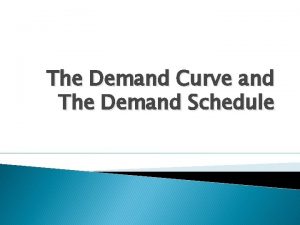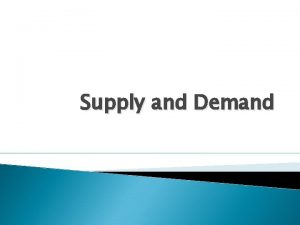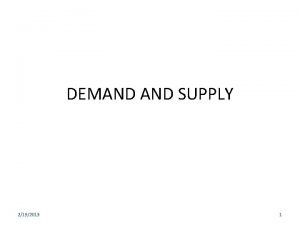Auditing The Demand for Auditing and Assurance The









































- Slides: 41

Auditing

The Demand for Auditing and Assurance The development of the corporate form of business and the expanding world economy over the last 200 years have given rise to an explosion in the demand for the assurance provided by auditors.

The Demand for Auditing and Assurance A public company is a company that sells its stocks or bonds to the public, giving the public a valid interest in the proper use, or stewardship, over the company’s resources. Managers Stockholders Agents Principals

What Creates the Demand for Auditing and Assurance? • Audits lend credibility to information by reducing information risk, the risk that information is materially misstated • Financial statement misstatements arise due to-– – Accidental errors Lack of knowledge of accounting principles Unintentional bias Deliberate falsification • Audits do not directly address business risk, the risk that a company will not be able to meet its financial obligations due to economic conditions or poor management decisions

Organization of the Public Accounting Profession • • • Sole proprietorship Partnerships Professional Corporation Limited Liability Partnership (LLP) Limited Liability Company (LLC)

Categories of Public Accounting Firms • • Local Regional National Big 4

The Big Four • • Deloitte Ernst+Young KPMG Pricewaterhouse. Coopers

Types of Professional Services • • Audit, Attestation and Assurance Tax Consulting Accounting Personal Financial Planning Litigation Support Fraud Investigation

Consulting Services Prohibited by the Sarbanes-Oxley Act • • • Bookkeeping Financial systems design and Implementation Appraisal or valuation services Actuarial services Internal audit outsourcing Management functions or human resource services Investment services Legal services and expert services Certain tax services 3 -9

1 -10 Typical Structure of a National CPA Firm Partners Managers Seniors Staff Assistant

Responsibilities on an Engagement • Partner—Overall responsibility is to assure that audit is performed in accordance with professional standards. • Manager—Supervise overall engagement. • Seniors—”In charge” auditor on a daily basis • Staff assistants—Work under the immediate supervision of the senior

Need for Professional Ethics • Responsibility to serve the public – CPA is representative of the public • Complex body of knowledge – Abundance of authoritative pronouncements • Standards of Admission to the Profession – Min. standards for education and experience • Need for public confidence – CPA product is credibility 3 -12

AICPA Code of Professional Conduct • Designed to provide a framework for expanding professional services and responding to changes in the profession • Two sections – Principles – Rules • Additional guidance – Interpretations – Ethics Rulings 3 -13

AICPA Professional Ethics 3 -14

Principles of the Code • • • Responsibilities The Public Interest Integrity Objectivity and Independence Due Care Scope and Nature of Services 3 -15

The Rules of the AICPA Code of Professional Conduct Rule 101 102 201 202 203 301 302 501 502 503 504 505 Title Independence Integrity and Objectivity General Standards Compliance with Standards Accounting Principles Confidential Client Information Contingent Fees Acts Discreditable Advertising and Other Forms of Solicitation Commissions and Referral Fees (Deleted) Form of Organization and Name 3 -16

Independence • Independence of mind (actual independence) • Independence of appearance Both are required. 3 -17

Threats to Independence (and an example of each) • CPA financial and other personal matters – Financial Self-Interest of CPA—CPA owns stock in the client – Adverse Interest— Litigation between client and CPA firm – Undue Influence--Pressure from client to reduce audit procedures • Interests of relatives and friends – Familiarity—Spouse holds a key position with client • CPA Performance of nonattest services – Self-Review—CPA firm has provided consulting services that relate to audit – Advocacy of client—CPA promotes client securities as part of an initial public offering – Management Participation—CPA Serves as officer of client 3 -18

Rule 102 • Rule 102 – Integrity and Objectivity – Applies to all members of the AICPA and to all services provided by CPAs – Violations • Makes, or permits or directs another to make, materially incorrect entries in a client’s financial statements or records • Fails to correct financial statements that are materially false or misleading when member has such authority • Signs, or permits or directs another to sign, a document containing materially false and misleading information 3 -19

Rule 201 • Rule 201 – General Standards – Apply to all CPA services – Member shall comply with following standards: • • Professional competence Due Professional Care Planning and Supervision Sufficient Relevant Data 3 -20

Rule 202 Standards Technical Body Standards • Auditing Standards Board (ASB) • Management Consulting Services Executive Committee (MCSEC) • Accounting and Review Services Committee (ARSC) • Statements on Auditing Standards • ASB, MCSEC, and ARSC • Statements on Standards for Attestation Engagements • FASB, GASB and FASAC Statements and related Interpretations • Statements on Standards for Consulting Services • Statements on Standards for Accounting and Review Services 3 -21

Rule 203 • Accounting Principles – Designates GAAP – The Statements and Interpretations of • FASB • GASB • FASAB 3 -22

Rule 301 • Confidential Client Information – A member in public practice shall not disclose any confidential client information without the specific consent of the client. – Auditors cannot directly disclose illegal acts by the client unless they have a legal duty to do so – Confidential but not privileged communications with client 3 -23

IIA Code of Ethics--Principles Internal auditors are expected to apply & uphold the following principles: • Integrity. The integrity of internal auditors establishes trust and thus provides the basis for reliance on their judgment. • Objectivity. Internal auditors exhibit the highest level of professional objectivity in gathering, evaluating, and communicating information about the activity or process being examined. Internal auditors make a balanced assessment of all the relevant circumstances and are not unduly influenced by their own interests or by others in forming judgments. • Confidentiality. Internal auditors respect the value and ownership of information they receive and do not disclose information without appropriate authority unless there is a legal or professional obligation to do so. • Competency. Internal auditors apply the knowledge, skills, and experience needed in the performance of internal auditing services. 3 -24

Forms of Audit and Attestation of Financial Statements 1 -25

Audit Report • Providing an independent and expert opinion on the fairness of financial statements through an audit is the most frequent attestation service • When performing an audit, the auditors obtain reasonable assurance that the statements are in conformity with GAAP 17 -26

Typical Coverage of Audit Reports on the financial statements ordinarily include an opinion that is on both the: • Financial statements themselves: – – Balance sheet Income statement Statement of cash flows Statement of retained earnings (equity) • Financial statement disclosures – The notes to the financial statements are considered an integral part of the financial statements 17 -27

Auditors’ Standard Report – Nonpublic Clients • Details – Title includes word independent – Ordinarily addressed to the company itself, the shareholders, the audit committee and/or the board of directors – Signed with name of CPA firm not individual partner unless sole practitioner – Dated as of the date on which the auditors obtained sufficient appropriate audit evidence to support their opinion 17 -28

The AICPA Standard Auditors’ Report-Introductory Paragraph We have audited the accompanying consolidated balance sheets of ABC Company and its subsidiaries, as of December 31, 20 X 1 and 20 X 0, and the related consolidated statements of income, retained earnings, and cash flows for the years then ended. 17 -29

The AICPA Standard Auditors’ Report— Management’s Responsibility Paragraph Management is responsible for the preparation and fair presentation of these consolidated financial statements in accordance with accounting principles generally accepted in the United States of America; this includes the design, implementation, and maintenance of internal control relevant to the preparation and fair presentation of consolidated financial statements that are free from material misstatement, whether due to fraud or error. 17 -30

The AICPA Standard Auditors’ Report: Auditors’ Responsibility Paragraphs Our responsibility is to express an opinion on these consolidated financial statements based on our audits. We conducted our audits in accordance with auditing standards generally accepted in the United States of America. Those standards require that we plan and perform the audit to obtain reasonable assurance about whether the consolidated financial statements are free of material misstatement. An audit involves performing procedures to obtain audit evidence about the amounts and disclosures in the consolidated financial statements. The procedures selected depend on the auditor's judgment, including the assessment of the risks of material misstatement of the consolidated financial statements, whether due to fraud or error. In making those risk assessments, the auditor considers internal control relevant to the entity's preparation and fair presentation of the consolidated financial statements in order to design audit procedures that are appropriate in the circumstances, but not for the purpose of expressing an opinion on the effectiveness of the entity's internal control. An audit also includes evaluating the appropriateness of accounting policies used and the reasonableness of significant accounting estimates made by management, as well as evaluating the overall presentation of the consolidated financial statements. We believe that the audit evidence we have obtained is sufficient and appropriate to provide a basis for our audit opinion. 17 -31

The AICPA Standard Auditors’ Report--Opinion Paragraph In our opinion, the consolidated financial statements referred to above present fairly, in all material respects, the financial position of ABC Company and its subsidiaries as of December 31, 20 X 1 and 20 X 0, and the results of their operations and their cash flows for the years then ended in accordance with accounting principles generally accepted in the United States of America. 17 -32

Auditors’ Standard Report – Public Clients • Differences from nonpublic – Includes the words “Registered” and “Independent” in the title. – References standards of the PCAOB rather than generally accepted auditing standards. – Includes less detailed discussions of management and auditor responsibilities – Includes an additional paragraph indicating that the auditors have also issued a report on the client’s internal control over financial reporting. • The report on internal control may either be presented separately or combined with the report on the financial statements into one overall report – Does not include section headings. 17 -33

Exhibit 1: The Auditor’s Standard Report Independent Auditor’s Report We have audited the accompanying balance sheet of X Company as of December 31, 20 XX, and the related statements of income, retained earnings, and cash flows for the year then ended. These statements are the responsibility of the Company’s management. Our responsibility is to express and opinion on these financial statements based on our audit. We conducted our audit in accordance with the standards of the Public Company Accounting Oversight Board. Those standards require that we plan and perform the audit to obtain reasonable assurance [italics added for emphasis] about whether the financial statements are free of material misstatement. An audit includes examining, on a test basis, evidence supporting the amounts and disclosures in the financial statements. An audit also includes assessing the accounting principles used and significant estimates made by management, as well as evaluating the overall financial statement presentation. We believe that our audit provides a reasonable basis [italics added for emphasis] for any opinion. In our opinion, the financial statements referred to above present fairly [italics added for emphasis], in all material [italics added for emphasis] respects, the financial position of X Company as of [at] December 31, 20 XX, and the results of its operations and its cash flows for the year then ended in conformity with accounting principles generally accepted in the United States of America. [Signature] [Date]

Types of Reports with Unmodified Opinions 1. Unmodified opinion—standard report. This report may be issued only when the auditors have obtained sufficient appropriate audit evidence to conclude the financial statements are not misstated and there is no need to alter the report for situations 2, 3 or 4 below. 2. Unmodified opinion—with an emphasis of matter paragraph. To emphasize a matter appropriately presented in the financial statements (e. g. , a change in accounting principles). 3. Unmodified opinion—with an other matter paragraph. To emphasize a matter other than those presented or disclosed in the financial statements (e. g. , other information in documents containing audited financial statements). 4. Unmodified opinion on group financial statements. When two or more CPA firms are involved in an audit and the group auditor (firm that does most of the work) does not wish to take responsibility for the work of the component auditors. 17 -35

Types of Reports with Modified Opinions 1. A qualified opinion states that the financial statements are presented fairly in conformity with generally accepted accounting principles “except for” the effects of some matter. 2. An adverse opinion states that the financial statements are not presented fairly in conformity with generally accepted accounting principles. 3. A disclaimer of opinion means that due to a significant scope limitation, the auditors were unable to form an opinion or did not form an opinion on the financial statements. 17 -36

Summary of Emphasis of Matter Paragraphs and Group Audits 17 -37

Summary of Appropriate Auditors’ Reports 17 -38

Reports to SEC • Forms filed with SEC which include audited financial statements – Forms S-1 through S-11 (registration statements) – Forms SB-1 and SB-2 (registration for small businesses) – Form 8 -K (current report) – Form 10 -Q (quarterly report) – Form 19 -K (annual report) • Auditors should be well versed on requirements of each form 17 -39

ISSUES AFFECTING THE PROFESSION • • • Expectations gap Litigation Earnings management and fraud Implementation/maintenance of SOX Globalization

End of Auditing
 Modern auditing and assurance services
Modern auditing and assurance services Modern auditing and assurance services
Modern auditing and assurance services Modern auditing and assurance services
Modern auditing and assurance services Parallel simulation audit
Parallel simulation audit Teori permintaan dan penawaran jasa audit
Teori permintaan dan penawaran jasa audit Internal auditing assurance & advisory services
Internal auditing assurance & advisory services Standards vs procedures
Standards vs procedures Module 5 supply and demand introduction and demand
Module 5 supply and demand introduction and demand Economic demand for auditing
Economic demand for auditing Measures to correct excess demand and deficient demand
Measures to correct excess demand and deficient demand Independent and dependent inventory
Independent and dependent inventory Grapikong paglalarawan ng demand schedule
Grapikong paglalarawan ng demand schedule Demand forecasting and estimation
Demand forecasting and estimation Distinguish between individual demand and market demand
Distinguish between individual demand and market demand Dependent demand items
Dependent demand items Inventory modeling
Inventory modeling Individual demand vs market demand
Individual demand vs market demand Independent demand examples
Independent demand examples Kontinuitetshantering i praktiken
Kontinuitetshantering i praktiken Novell typiska drag
Novell typiska drag Nationell inriktning för artificiell intelligens
Nationell inriktning för artificiell intelligens Returpilarna
Returpilarna Shingelfrisyren
Shingelfrisyren En lathund för arbete med kontinuitetshantering
En lathund för arbete med kontinuitetshantering Underlag för särskild löneskatt på pensionskostnader
Underlag för särskild löneskatt på pensionskostnader Personlig tidbok för yrkesförare
Personlig tidbok för yrkesförare Sura för anatom
Sura för anatom Vad är densitet
Vad är densitet Datorkunskap för nybörjare
Datorkunskap för nybörjare Tack för att ni lyssnade bild
Tack för att ni lyssnade bild Hur skriver man en tes
Hur skriver man en tes För och nackdelar med firo
För och nackdelar med firo Nyckelkompetenser för livslångt lärande
Nyckelkompetenser för livslångt lärande Påbyggnader för flakfordon
Påbyggnader för flakfordon Lufttryck formel
Lufttryck formel Publik sektor
Publik sektor Jag har gått inunder stjärnor text
Jag har gått inunder stjärnor text Presentera för publik crossboss
Presentera för publik crossboss Teckenspråk minoritetsspråk argument
Teckenspråk minoritetsspråk argument Kanaans land
Kanaans land Klassificeringsstruktur för kommunala verksamheter
Klassificeringsstruktur för kommunala verksamheter Fimbrietratt
Fimbrietratt
